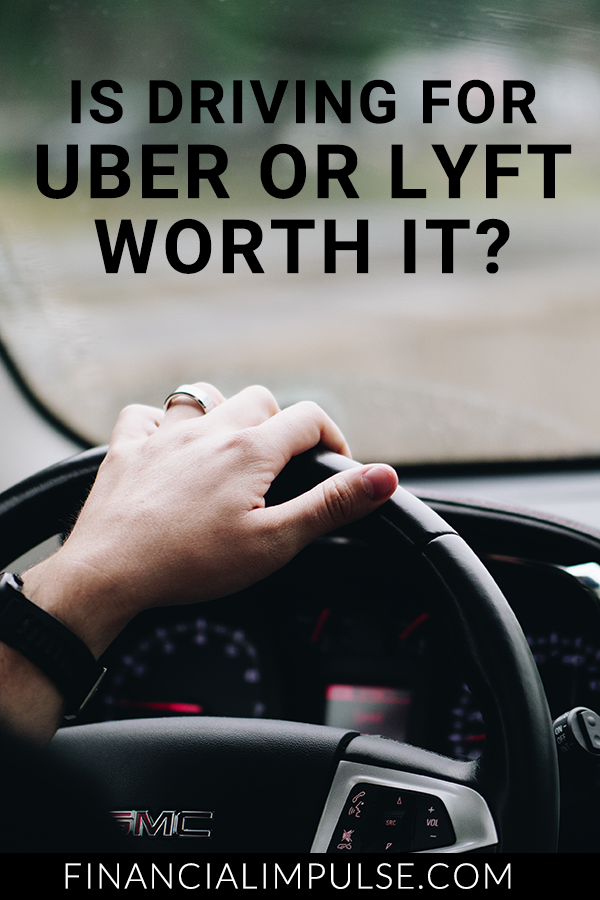More and more people are taking advantage of side gigs to supplement their income—and perhaps no other gig better exemplifies this than rideshare platforms like Uber and Lyft.
Financial Impulse’s “Is It Worth It?” series takes a close look at high-cost items and experiences with the mission to break down their costs and benefits. In this post, however, we’ll take a look at a side hustle and evaluate whether it’s worth pursuing as a way to make more money.

The gig economy is booming, with more and more people taking advantage of “side gigs” to supplement their income. Perhaps no other gig better exemplifies this than driving for rideshare platforms like Uber and Lyft.
While getting a ride from a stranger was once viewed as an open invitation for danger in the 1990s, it’s now become the norm. Although the pandemic briefly cut down demand for rideshare services, many people are back to hailing Ubers and Lyfts. In fact, an estimated 93 million people around the world use Uber on a monthly basis.
So despite the chaos of the past few years, driving for Uber and Lyft is still a common side hustle today.
But just how lucrative is it to drive for these rideshare platforms? If you have a car, is it worth it to drive for Uber or Lyft?
Below, we’ll take an in-depth look at rideshare services and consider the pros and cons of driving for Uber and Lyft.
Table of Contents
- Driving Requirements
- How much can you make driving for Uber or Lyft?
- The Pros and Cons of Driving for Uber and Lyft
- Additional Considerations
- Conclusion
Driving Requirements
To begin with, not just anyone can become a rideshare driver. Interested candidates must meet the following requirements:
Uber
|
Lyft
|
These aren’t all, though—most cities also have local requirements for applicants, like vehicle registration and stipulations on the age of the vehicle you use.
What if you don’t have a car?
You can still become a driver by renting a car. Services like RideShare Rental, HyreCar, and Fair exist for this very purpose, letting car owners rent out their vehicles for rideshare drivers. (Think gig economy meets Inception—a side hustle within someone else’s side hustle.) You can also rent from traditional rental companies like Hertz.
How much can you make driving for Uber or Lyft?
Uber once famously advertised that drivers in New York earned $90,000 a year. Sound too good to be true? That’s because it is.
In fact, these claims landed Uber in trouble with the Federal Trade Commission, leading to a $20 million penalty.
So how much can you realistically make driving for Uber or Lyft? Or in other words, how much do Uber and Lyft take from drivers?
Since ride-hailing companies function as a middleman by connecting drivers with passengers, they take a cut of each trip’s fare. For Uber, this is a 25% commission. Lyft, on the other hand, doesn’t provide a specific rate on its website, but people report it taking a minimum of 20-25%.
For a better idea of how payment looks, here’s what you might expect to earn according to TheStreet:
| Pay Per Ride | Pay Per Hour | |
| Uber | $15.97 | $8.55–$11.77 |
| Lyft | $11.48 | $8.55–$11.77 |
However, it’s important to note that this data is not exact. Rideshare earnings vary for several reasons:
- The commission and fees that rideshare companies charge have changed over time, and are still subject to further change. It’s no surprise that Uber and Lyft have adjusted their pricing models over the years. Research by the Rideshare Guy shows that drivers only had to travel 2.36 miles to make $10 in 2013; however, by 2016, this amount had increased to 4.71 miles.
- Individual driver differences affect earning potential. That includes differences in a driver’s location, the number of hours worked, and the availability of surge pricing. As a result, a suburb-based driver using the app only on weekend afternoons will not earn the same amount as a city-based driver that uses the app every weekday evening.
- The amount of tip drivers receive varies. While Lyft has long allowed tipping on its app (with an upgrade in November 2018), it wasn’t until July 2017 that Uber rolled out this function. However, tipping also varies between passengers, as there are different perspectives on how much is appropriate. If you’re lucky, though, you just might score a very generous passenger.
- Driver income also varies based on the kind of rideshare service you offer and the frequency of ride requests you receive. Economy services like UberX, Comfort, and UberXL cost less than Uber Premier—though this alone doesn’t mean Uber Premier drivers get paid more. Fewer passengers translate into fewer customers. Because of this, some Uber drivers opt to do food deliveries for Uber Eats in between passenger rides.
Given all of these factors, we recommend doing some research on how much rideshare drivers in your city or region make. Now that these services have been around for a while, this data is more readily available than it was a few years ago.
Uber even offers an interactive calculator to show how much drivers can expect to make based on their location and the number of hours they work. For example, according to this calculator, driving around 50 hours/week in Houston can earn you around $1,130/week, including $116 in tips.
The Pros and Cons of Driving for Uber and Lyft
Driving for rideshare services comes with its fair share of drawbacks and advantages. Below, we look at the major pros and cons of driving for them.
Pro: It’s a flexible gig
Unlike the standard 9-to-5 or part-time job, you don’t need to clock in to your rideshare app at a designated time; it’s your discretion when you’ll drive for Uber or Lyft, and how often.
You can use this to your advantage by driving when it’s convenient for you, although it also helps to consider when the need for drivers is greatest.
To maximize his time spent on the app, Riley Adams, a CPA and personal finance writer behind Young and the Invested, did some experimenting to find out when fares would have the highest ROI.
“Living in New Orleans at the time, that meant late nights around the French Quarter, early mornings for bringing people to the airport, and weekend afternoons,” Adams says.
“I found the early morning airport runs to be the most lucrative because of low competition and a mandatory minimum rate enforced by the City Council of New Orleans. It provided for a subsidized rate and would quickly add up if you could snag three rides before work… Moreover, it was the most predictable and fit most naturally to my schedule.”
Pro: The payout schedule is more frequent compared to other gigs
Compared to a traditional semimonthly or biweekly paycheck, Uber and Lyft generally pay drivers on a weekly basis through direct deposit. Payment includes ride earnings and tips, as well as other bonuses such as driver and rider referrals.
However, the introduction of Uber’s Instant Pay and Lyft’s Express Pay now allows drivers to receive earnings immediately, so long as they meet certain requirements. These options makes driving for a rideshare platform ideal for anyone in immediate need of money.
Con: Vehicle maintenance can be costly
Regardless of whether you owe any car payments, driving doesn’t come for free. The costs of vehicle maintenance can quickly add up. These expenses include:
- Gas
- Oil changes
- Tire rotations
- Car washes
And if you decide to drive full-time, you need to also factor in healthcare and retirement costs as an independent contractor rather than an employee at a company that provides benefits. Added up, these hidden costs make driving for Uber or Lyft less lucrative as a side hustle.
Con: Driver support is lacking
Harry Campbell, the blogger behind The Rideshare Guy, notes that transportation network companies (TNCs), the likes of which include Uber and Lyft, are “so bad at communication, training, and helping out their drivers.”
Campbell refers to the lack of administrative and operations support, but there have also been allegations against Uber and Lyft for inadequately addressing female drivers’ safety concerns. Numerous drivers have reported issues such as sexual assault and harrassment, and felt that the ride-hailing platforms have done little to protect both drivers and passengers.
Additional Considerations
The volume of rides you receive varies based on your location.
So many variables tied to location—for instance, climate, time of the year, and population size—ultimately affect how lucrative it is to drive for a rideshare app.
Josh Overmyer, a personal finance blogger based in southwest Florida, describes how seasonal fluctuations affected the number of passengers requesting rides when he drove for Uber.
“Snowbirds and other tourists flock here in the winter/spring, and then we get really slow in the summer and most of fall because of hurricane/rainy season. I would drive almost every day during season, and then only a day or so a week during the summer.”
Driving for Uber or Lyft entails interacting with people.
This can be a pro or a con depending on your personality and personal preference. While some drivers enjoy the prospect of meeting and chatting with passengers, others dislike it.
Of course, there’s no telling what kind of passenger will end up in your car in the first place; that could be a perfectly pleasant passenger or a rude backseat driver. And depending on when you decide to drive, you might also pick up inebriated passengers who have little regard for your vehicle.
For Jerry Brown, personal finance blogger at Peerless Money Mentor, driving for Uber in Louisiana led to interesting conversations with business owners, musicians, and other professionals.
That said, the flexibility of being able to decide when you want to drive means you can turn off the app when you’re feeling socially drained.
Conclusion: Is driving for Uber or Lyft worth it?
The verdict: If you’re looking for a small income boost in the short term, it’s worth signing up as an Uber or Lyft driver. For a more meaningful long-term side hustle, look elsewhere.
From a cost perspective, Mark Huntley, co-founder of Credit Knocks, points out that the financial return may simply not be there. “If you use the IRS mileage rates of $0.58 a mile and drive a vehicle that uses gasoline, then you can’t make minimum wage driving for a rideshare. At least, I was unable to, and I tracked every mile, cent spent, and hour in the seat.”
Adams agrees: “Long-term, I didn’t feel the money was worth it for the wear and tear placed on my vehicle and for the use of my time. I discontinued the side gig after more career development opportunities presented themselves and would make for more lucrative improvements to my earnings ability in the long term.”
In the short term, however, driving for Uber or Lyft may be worth it if:
- Your current schedule does not easily allow for more regimented part-time work
- You live in a fairly populous area, with a moderate to high demand for drivers
- You need income immediately
- You don’t mind or can at least tolerate regular interaction with strangers
Provided that you have easy access to a qualifying vehicle, getting set up with Uber or Lyft is relatively quick compared to other gigs that demand more training, upfront costs, or have a steeper learning curve. And fortunately, given its flexibility, you can drive for as long or as short as you’d like—in other words, you can try it out for just a month and stop and return to it whenever necessary.






I wish it was only 25% like it used to be.
What’s the latest? Would definitely like to update this post with the latest rates.